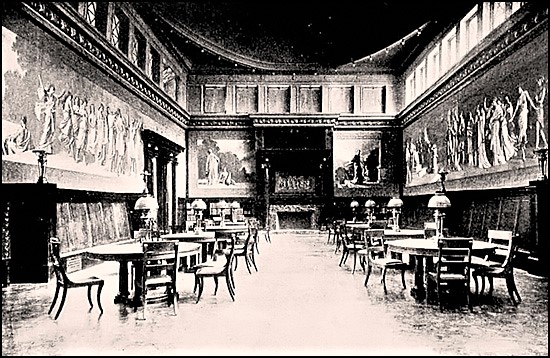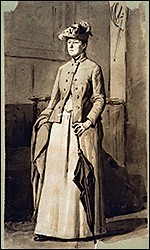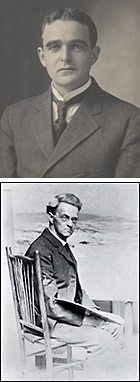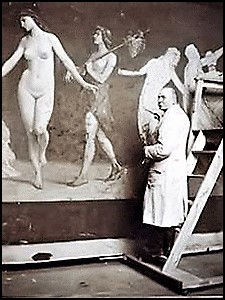

“I was invited to return to America to paint the walls of the library in Franklin, Massachusetts, a small town a half hour from Boston, where there is an Academy of Science and Letters . . .”


Taking up residence in Turin and Florence after his 1891 departure from the United States, Juglaris remarried. Although Boston newspapers reported rumors that Juglaris’s new wife was an Italian countess, she was actually the widow of an old friend who had served as personal physician to the Italian liberator Giuseppe Garibaldi. However, due to his wife’s poor physical and emotional health, Juglaris’s happiness with Marzia Copello Camposoprano proved short-lived. Only six years after their marriage, he was widowed for a second time. He chose never to marry again.
In Turin and Florence Juglaris continued to pursue his vocation as an artist, regularly exhibiting works that emerged from his easel. Meanwhile, a number of his faithful American students and friends remained in constant correspondence with him. One of them, Henry Hammond Gallison, a jurist as well as a painter, solicited Juglaris’s talents for the embellishment of a new building for America’s oldest public library in Franklin, Massachusetts, outside Boston.

Gallison was a trusted friend to the wealthy daughters and heirs of a local mill owner. They sought a suitable memorial to honor their late father and mother, Joseph and Emily Ray, while benefitting their hometown. The capable and ingratiating Gallison offered to supervise the entire library project from start to finish on behalf the Ray sisters. Among other things, he saw it as an occasion not only to collaborate with one of Boston’s more promising young architects, Theodore H. Skinner of Rand & Skinner, but also with Juglaris, his cherished friend and former teacher.
A M.I.T. graduate formerly employed with McKim, Mead, and White, Skinner came to be architecturally known for libraries and other buildings at Mount Holyoke and Smith Colleges, as well as Columbia University, City University of New York (CUNY), and the University of Virginia. At Gallison’s request he designed the Franklin Library in the style of an ancient Greek temple. For interior decorations Gallison planned to personally execute several massive landscape paintings. But he commissioned Juglaris to create a vast Reading Room mural cycle in sync with Skinner’s classical temple scheme. Later, Gallison further commissioned Juglaris to paint a series of five friezes for an adjoining “Memorial Hall” that also served as the library’s grand entrance.
Recalled to America in this way from 1902 to 1905, Juglaris recognized a splendid opportunity to demonstrate his talents for truly monumental painting that he never had the chance to display in the heart of Boston. Indeed, ten years previously, Juglaris had been overlooked or bypassed when artists were tapped to decorate the new Boston Public Library in Copley Square designed by Charles McKim of McKim, Mead, and White. Reflecting some injured pride and a highly competitive spirit as he set to work at Franklin, Juglaris confided to his memoir: “[At] the Boston library there were decorations by Puvis de Chavannes, by [John Singer] Sargent, by [William Merritt] Chase {sic] and others but…I must do better, especially more pleasing decorations.”
As his work on the murals got underway, Juglaris divided his time between Franklin and studios in Providence, Rhode Island, and Annisquam, Massachusetts. The latter was an artist’s colony on Massachusetts Bay where Gallison kept a summer place. In Annisquam Juglaris stayed at a local resort hotel and wrote letters to a friend, the Italian archaeologist and literary figure Edoardo Calandra. Preserved in the archives of the J. Paul Getty Museum in Los Angeles, the letters marvel at the progress the United States had made in the decade of his absence. Juglaris forecast a brilliant future for the young nation:

“Imagine, when I left Boston eleven years ago, it had five hundred thousand inhabitants. It now has more than a million. Elevated and underground railroads, immense stations, splendid streets and roads with huge palaces, ugly but amazing [apartment] buildings twenty or twenty-five stories high, steam and electric elevators, omnibuses, streetcars, vehicles of every kind. A frenetic, exciting coming and going. In short, it is a country that will dominate the universe and educate the world. [It is] impossible to describe the progress of this great people.”
It took three years for Juglaris to finish his murals and friezes, respectively entitled Grecian Festival and The Hours. Combined, they constituted the largest mural project to be found in the United States. Juglaris’s passion and sense of pride in completing this bravura master-work is revealed in the self-portrait found in the southeast corner of the Reading Room mural where he observes in perpetuity the broad sweep of the great festival.
As Juglaris’s murals and friezes reached completion and word of their magnitude spread, public interest was piqued, generating extensive newspaper coverage. One newspaper predicted that Juglaris’s murals would make the Franklin Public Library a “Mecca for art lovers.” Although the excitement faded after the dedication of the library, Juglaris’s work continued to be greatly admired by those who found their way to Franklin. One of those admirers was former U.S. President and Supreme Court Chief Justice William Howard Taft who toured the library after delivering a commencement address at Dean Academy (now Dean College) across the street. More than a century later, Juglaris’s mural and friezes at the Franklin Public Library survive intact, a testimony to his talent and creative vision.